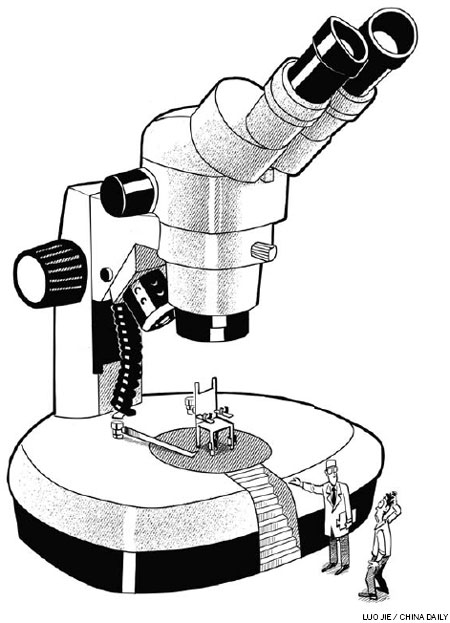Op-Ed Contributors
Debate: More AIDS tests
(China Daily)
Updated: 2010-12-06 07:16
 |
Large Medium Small |
Ray Yip
Early diagnosis will help save lives

China has an estimated 750,000 HIV positive patients. Considering China's 1.3 billion population, the number of people living with HIV/AIDS in the country is relatively low, especially when compared with the United States, where the infection rate is about five times higher.
A relatively low rate of infection, by implication, offers a better chance of implementing effective measures to prevent the spread of a disease, HIV/AIDS is no exception. But there is a major difference between China and the US. About 80 percent of the people living with HIV/AIDS in the US know they are infected, whereas only 25 percent of such people in China are aware of their medical condition.
Why does knowing about one's HIV condition matter? An HIV positive person who knows about his/her infection is more likely to make efforts not to spread the disease than those who remain unaware. A number of international studies show the chance of an HIV positive person spreading the disease is reduced two-thirds if he/she is aware of his/her medical condition.
Nowadays, with the availability of highly effective antiretroviral (ARV) drugs, not only can a patients' life be extended, but also ARVs suppress the human immunodeficiency virus to levels low enough to make patients on therapy nearly "non-infectious".
The truth is that HIV positive people who do not know their medical condition not only cannot benefit from the potentially life-saving effect, but also make them disease-transmission agents. In essence, HIV tests for early detection, like in most other communicable diseases, can prevent the disease from spreading.
Why this emphasis on HIV positive patients in China knowing about their medical condition? The emphasis is not because the current policy, known as "prevention with positives", is too weak. On the contrary, China has a very strong policy for this effort, as the "four frees and one care" policy implemented in 2004 shows. Among the "four frees" are free HIV testing and antiretroviral drug treatment. The third is the free routine HIV test offered to pregnant women and ARVs provided to mothers who have tested HIV-positive to prevent mother-to-child transmission. This is a perfect example of "prevention with positives".
Despite such a clearly focused policy, why does China lag behind in "prevention with positives"? Given the funds allotted for HIV/AIDS prevention and control in China, it would be fair to say that it has nothing to do with resource constraints. The main reason why the country lags behind in efforts to prevent the spread of and control the disease can be traced to technical and managerial obstacles. Access to HIV tests is limited and inconvenient, and many aspects of the test discourage people from taking it.
Liberalizing the testing policies and procedures and allowing community health clinics to be part of the group of medical facilities offering free HIV tests will be a giant leap forward in improving accessibility. The more widespread use of a rapid test instead of the traditional testing procedure would shorten the time of getting the result from 1-2 weeks to 30 minutes and make testing more attractive. The key is to make it easier and more routine to get HIV testing.
There is a historical reason why HIV tests have been treated carefully to the point where existing procedures impede efforts of effective prevention. Since AIDS was diagnosed as a disease, a stigma has been associated with it. That stigma is still prevalent in China. An HIV positive patient in China still faces severe discrimination, especially when it comes to getting a job, or buying or renting a house.
Before the availability of ARV drugs, many people gained little or nothing by knowing that they were HIV-positive apart from being cautious enough not to transmit the disease to their loved ones. That's why HIV tests should be carried out extremely carefully, at least to prevent causing harm to HIV positive patients.
But one has to realize that the widespread availability of ARV drugs has changed the game entirely. Not only does early diagnosis prevent the spread of HIV/AIDS, but also it saves lives. Contracting HIV/AIDS is no longer tantamount to be given a death sentence. Rather it opens up the possibility of getting lifelong, routine treatment.
The realization of the importance of early diagnosis through an HIV/AIDS test has gradually changed the attitude of people in the US and other Western countries. What began as a highly restrictive approach in the 1990s has become a more liberal and routine process, especially over the past decade. China can catch up with the Western world fast if its people realize the importance of effective "prevention with positives", especially because the country has little or no constraints in terms of commitment and resources. The key is to adopt a more up-to-date approach that will substantially improve the efficiency and effectiveness of HIV tests.
For the question, "will China be able to control AIDS soon", the answer is "yes" if more than 60 percent of HIV positive people in China know their medical condition. The answer is based on an international model on the effectiveness of various HIV-related intervention measures.
If health centers across China can be authorized and supported to conduct HIV tests, I am pretty optimistic China can raise the current level of only 25 percent HIV infected people knew their medical condition to 60 percent within a few years. When that happens HIV epidemic would be under control.
The author is China country director of Bill & Melinda Gates Foundation.
(China Daily 12/06/2010 page9)